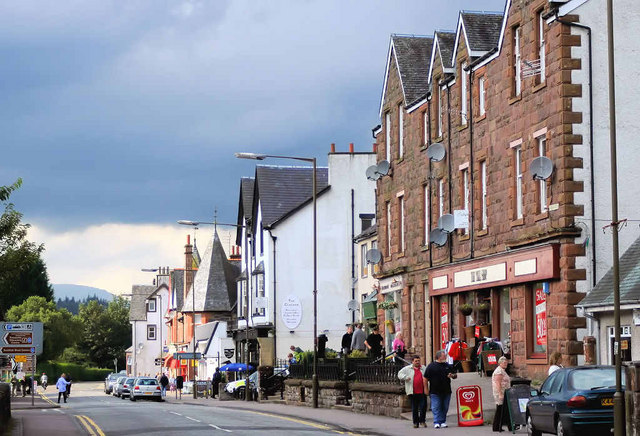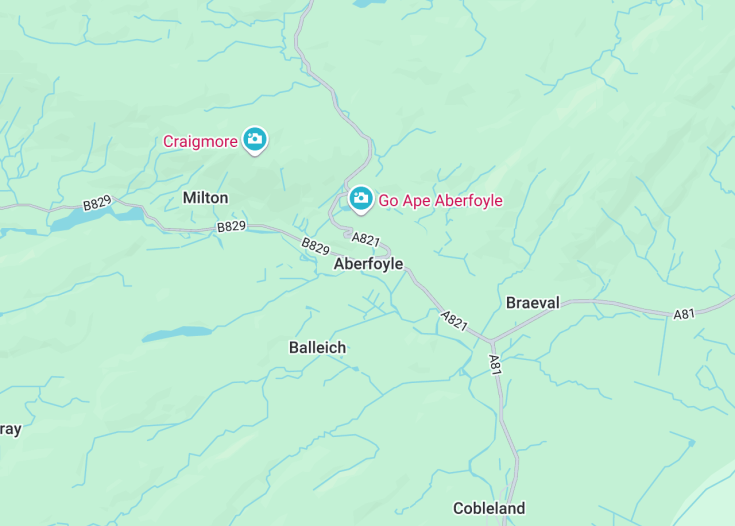Aberfoyle, nestled at the southern gateway to the Scottish Highlands, offers an enchanting landscape steeped in folklore and natural beauty. This picturesque village is renowned for its proximity to the Loch Lomond and The Trossachs National Park, providing a perfect setting for hiking, cycling, and wildlife watching. Aberfoyle is rich in history, once a hotspot for 19th-century tourists and famous for its associations with Sir Walter Scott’s literary works. Its captivating scenery, coupled with a serene environment, makes it an irresistible destination for those seeking both relaxation and adventure amidst Scotland’s stunning countryside.
When visiting Aberfoyle, ensure to explore the scenic walking trails of the Queen Elizabeth Forest Park, a haven for nature lovers and a perfect place for picturesque picnics.
Plan your trip to Aberfoyle during the spring or autumn to witness the spectacular change in seasons and the rich tapestry of colors these times of the year bring.
Top things to do & see in Aberfoyle
Select the following sights and activities to discover best tickets and tours available in Aberfoyle.
Aberfoyle: A Gateway to the Trossachs National Park
| Country | Scotland (United Kingdom) |
| Time in Aberfoyle | GMT+0 |
| Language spoken | English |
| Population | 1,200 (Population data based on local government statistics) |
| Currency | Pound Sterling (£, GBP) |
| Airports |
|
Aberfoyle is a charming village nestled in the heart of Scotland’s scenic Loch Lomond and the Trossachs National Park. Known for its picturesque landscapes and as a hub for outdoor activities, this locale serves as a perfect escape for nature lovers and adventure seekers. Its proximity to Loch Katrine and Ben Lomond offers ample opportunities for hiking, cycling, and water sports. Historically, Aberfoyle was famed for its wool production and as a haunt of legendary outlaws like Rob Roy MacGregor, enriching the area with tales of folklore and history.
Where is Aberfoyle?
Aberfoyle lies in Central Scotland, nestled at the southern edge of the Highlands, offering a lush gateway to the renowned mountains and lochs of the Trossachs.
Distances:
| Route | Distance by car | Time by car |
|---|---|---|
| From Glasgow | 27 miles (43 km) | 1 hour |
| From Edinburgh | 56 miles (90 km) | 1 hour 20 mins |
| From Stirling | 21 miles (34 km) | 35 minutes |
What is Aberfoyle famous for?
Aberfoyle is renowned for its close connection to Scottish folklore and history, notably through its ties to Rob Roy MacGregor, a local folk hero. It’s also celebrated for its stunning natural surroundings which form an indispensable part of Loch Lomond and the Trossachs National Park.
History
Pre-18th Century: Early Settlements and Development
The region of Aberfoyle, nestled within the scenic landscapes of Stirling, Scotland, has seen human activity dating back to the prehistoric times, evidenced by the various standing stones and burial mounds scattered around the area. The name Aberfoyle itself is derived from the Scottish Gaelic, meaning “confluence of the river Foyle,” pointing to the settlement’s origins tied closely to the natural landscape and waterways that made it a favorable habitation site. The early inhabitants, primarily pastoral and agricultural societies, took advantage of the fertile lands and abundant resources, setting the groundwork for the growth of Aberfoyle through the medieval era.
18th Century: The Trossachs Discovery
The 18th century marked a pivotal transformation in Aberfoyle’s history with the “discovery” of the Trossachs by literary figures and artists. The publication of Sir Walter Scott’s “The Lady of the Lake” in 1810 heralded the region into prominence, romanticizing its landscapes and thus attracting an influx of visitors. This period saw Aberfoyle becoming a central hub for the early stages of Scottish tourism, fostering the establishment of local inns and the development of transportation routes to accommodate the burgeoning number of visitors drawn by its depicted beauty and romantic allure.
19th Century: Industrialization and Expansion
The 19th century ushered in an era of industrialization, which albeit late, did not overlook Aberfoyle. The introduction of the slate quarrying industry significantly impacted the local economy, providing employment and altering the landscape. The arrival of the railway in 1882 further amplified Aberfoyle’s accessibility, making it an important commercial and touristic node within the region. Despite these industrial changes, Aberfoyle maintained its charm, with preserved natural beauty and an increasingly celebrated cultural heritage.
Visit Aberfoyle
What to see and do in Aberfoyle, Scotland (United Kingdom)
Aberfoyle, a gateway to the Loch Lomond and Trossachs National Park, offers a plethora of natural and cultural attractions:
- Explore the Queen Elizabeth Forest Park, a haven for hikers and wildlife enthusiasts.
- Visit the Scottish Wool Centre to understand local crafts and watch sheepdog demonstrations.
- Take the scenic drive or cycle around the Duke’s Pass, known for its stunning views.
- Discover the eerie tales and historical depth of the old Kirk and its famous cemetery, linked to the legendary Rob Roy MacGregor.
Festive Delights in Aberfoyle
Aberfoyle buzzes with excitement during its annual Highland Games, typically held in July. This event promises a spectacular display of traditional Scottish sports, dances, and music, drawing both locals and tourists into the rich cultural tapestry of the Highlands.
Best time to visit Aberfoyle
The best time to visit Aberfoyle is during the spring (late April to June) and early autumn (September to early October), when the weather is mild and the natural scenery is at its most vibrant.
Is Aberfoyle worth visiting?
Indeed, Aberfoyle is worth visiting for anyone with a penchant for natural beauty, history, and outdoor activities. The village serves as a perfect retreat for those looking to escape the hustle and bustle of city life while immersing themselves in the tranquility and scenic splendor of Scotland’s landscapes. The rich cultural heritage and the warm hospitality of the local community add to the charm of this picturesque destination.









